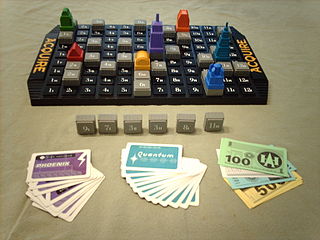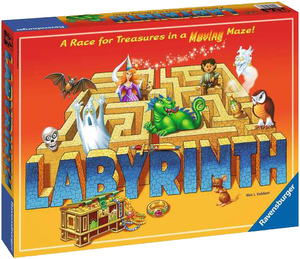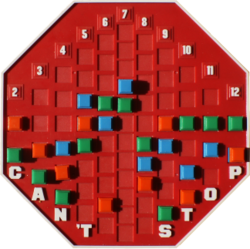
Acquire is a board game published by 3M in 1964 that involves multi-player mergers and acquisitions. It was one of the most popular games in the 3M Bookshelf games series published in the 1960s, and the only one still published in the United States.

Ludo is a strategy board game for two to four players, in which the players race their four tokens from start to finish according to the rolls of a single die. Like other cross and circle games, Ludo is derived from the Indian game Pachisi. The game and its variations are popular in many countries and under various names.

Scotland Yard is a board game in which a team of players controlling different detectives cooperate to track down a player controlling a criminal as they move around a board representing the streets of London. It was first published in 1983. It is named after Scotland Yard which is the headquarters of London's Metropolitan Police Service in real-life. Scotland Yard is an asymmetric board game, during which the detective players cooperatively solve a variant of the pursuit–evasion problem. The game is published by Ravensburger in most of Europe and Canada and by Milton Bradley in the United States. It received the Spiel des Jahres award in 1983-the same year that it was published.
Sid Sackson was an American board game designer and collector, best known as the creator of the business game Acquire.
A Gamut of Games is an innovative book of games written by Sid Sackson and first published in 1969. It contains rules for a large number of paper and pencil, card, and board games. Many of the games in the book had never before been published. It is considered by many hobbyist gamers to be an essential text for anyone interested in abstract strategy games, and a number of the rules were later expanded into full-fledged published board games.

Pig is a simple dice game first described in print by John Scarne in 1945. Players take turns to roll a single dice as many times as they wish, adding all roll results to a running total, but losing their gained score for the turn if they roll a 1.

Railway Rivals is a railroad-themed board game that was originally published by Rostherne Games in 1973. A German language edition was released by Bütehorn in 1979, and a mass-market edition in the UK by Games Workshop in 1985. The game involves railway building and operations.

Cee-lo is a gambling game played with three six-sided dice. There is not one standard set of rules, but there are some constants that hold true to all sets of rules. The name comes from the Chinese Sì-Wŭ-Liù (四五六), meaning "four-five-six". In America it is also called "See-Low," "Four-Five-Six," "The Three Dice Game," "Roll-off!," and by several alternative spellings, as well as simply "Dice." In China it is also called "Sān Liù Bàozi" (三六豹子), or "Three-Six Leopards". In Japan, it is known as "Chinchiro" (チンチロ) or "Chinchirorin" (チンチロリン).
Dice chess can refer to a number of chess variants in which dice are used to alter gameplay; specifically that the moves available to each player are determined by rolling a pair of ordinary six-sided dice. There are many different variations of this form of dice chess. One of them is described here.

Labyrinth is a board game for two to four players, published by Ravensburger in 1986.
Orient Express is a crime fiction board game published by Jumbo and Just Games. The game is based on the 1934 novel Murder on the Orient Express by Agatha Christie. The game was designed by Jeff Smets and released in 1985. The game contains 10 different murder cases, each of which can be played only once. Five new plots were released in 1987.
Diamant is a multiplayer card game designed by Alan R. Moon and Bruno Faidutti, published in 2005 in Germany by Schmidt Spiele, with illustrations provided by Jörg Asselborn, Christof Tisch, and Claus Stephan.
A number of related games under the Yahtzee brand have been produced. They all commonly use dice as the primary tool for game play, but all differ generally. As Yahtzee itself has been sold since 1954, the variants released over the years are more recent in comparison, with the oldest one, Triple Yahtzee, developed in 1972, eighteen years after the introduction of the parent game.

Las Vegas is a board game designed by Rüdiger Dorn and published by Ravensburger in 2012. It is named after the city of Las Vegas in Nevada, United States and has a gambling theme. The game was also nominated for the Spiel des Jahres prize in 2012.
Sleuth is a strategy deduction card game designed by Sid Sackson and published by 3M in 1971. It is a reimplementation of the 1967 game The Case of the Elusive Assassin without the game board. The object of the game is to deduce the identity of a missing gem by questioning other players and gathering evidence, similar to Cluedo.
Hexagony is an abstract strategy board game for 2 to 6 players that was published as Bin'Fa by Taoist Arts Inc. in 1977, as Hexagony by Avalon Hill in 1980, and later re-released in a slightly modified form by Kenterprises as Bin'Fa.

Armada is a board game published by Jeux Descartes in 1986. After Jeux Descartes published a second edition, Eurogames published a third edition in 2001 that changed the theme of the game from colonisation to treasure-seeking pirates.
Can't Stop Express is a board game published in 1989 by Hexagames in which players strategize and score points using dice combinations.
Hexagames was a German game publisher in Dreieich, which existed from 1982 to 1992. It was one of the most famous German game publishers of the 1980s, notable for publishing games such as Lines of Action (1988) and Cosmic Encounter (1992).
The Generals, or The Generals Electronic Strategy Game, is an electronic abstract strategy game published in 1980 by Ideal Toy Company. It implements the gameplay of the 1970 game Game of the Generals, in which two players contest control of spaces on a game board by moving game pieces with ranks hidden to their opponent and challenging opposing pieces; the results of challenges are determined by the hierarchy of ranks of those pieces, in a manner similar to Stratego, and decided by an electronic arbiter.










